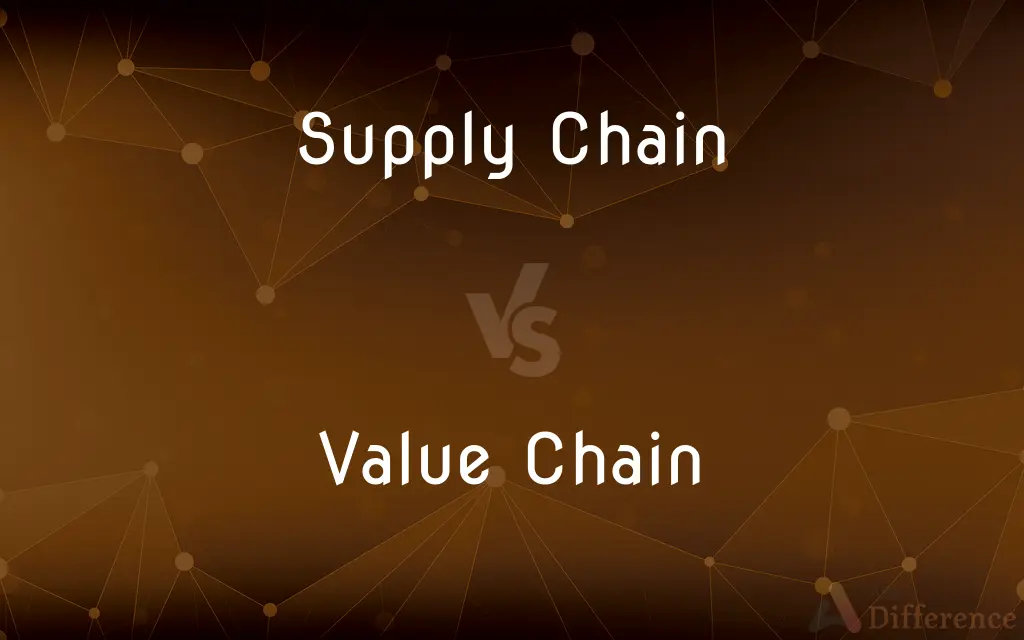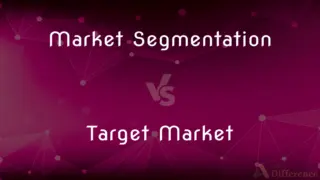Supply Chain vs. Value Chain — What's the Difference?
By Tayyaba Rehman — Published on November 7, 2023
Supply Chain manages the flow of goods and services from manufacturers to consumers. Value Chain involves all activities that add value to a product from conception to delivery.

Difference Between Supply Chain and Value Chain
Table of Contents
ADVERTISEMENT
Key Differences
A supply chain refers broadly to the entire system of activities, people, organizations, resources, and information involved in moving a product from its supplier to customer. The value chain, conceptualized by Michael Porter in 1985, elaborates on all the discrete activities that businesses undergo to create a product or service, from inception to delivery, each adding some form of value to the final offering.
The core intent of a supply chain is to fulfill customer needs through the most efficient and economical use of resources, including distribution capacities and inventory. Whereas the value chain analyzes how organizations can deliver superior value through examining how each activity (like inbound logistics, operations, outbound logistics, marketing, and sales, and service) enhances the product or service from a customer and business perspective.
When visualizing the supply chain, it's often seen as a series of interlinked processes – production, warehousing, and distribution – which cater to fulfilling customer orders and maintaining optimal stock levels. The value chain, in contrast, is more internally focused, critically examining every specific activity within the company, from procurement to after-sales services, to understand how each could be optimized or refined to provide maximal value.
Supply chain management emphasizes reducing costs and inefficiencies, ensuring the timely and economical delivery of goods and services. The value chain dissects the company’s activities, looking at how each can be harnessed to gain a competitive edge, whether through cost leadership or differentiation, to deliver a unique value proposition to customers.
While supply chains often utilize metrics like delivery times, costs, and production quotas to evaluate performance, the value chain may implement measures relating to product innovation, customer experience, and brand equity, reflecting the different orientations and focal points of the two concepts.
ADVERTISEMENT
Comparison Chart
Primary Focus
Efficient flow of goods and services
Enhancing value in business activities
Orientation
External processes
Internal processes
Goal
Cost-efficiency and timely delivery
Competitive advantage
Evaluation Metrics
Delivery times, costs, production
Innovation, customer experience
Framework Originator/Concept
N/A
Michael Porter (1985)
Compare with Definitions
Supply Chain
The supply chain encompasses the entire network of entities directly involved in creating and distributing a product.
The global chip shortage disrupted the auto industry's supply chain.
Value Chain
In a value chain, each activity should contribute to improving the product or service and thus enhancing the customer’s perception of its value.
By optimizing its value chain, the business was able to innovate and enhance customer experiences.
Supply Chain
A supply chain seeks to manage and control the production flow from raw materials to the delivery of the final product.
Efficient supply chain management reduced production delays.
Value Chain
The value chain perspective evaluates how well a company converts input costs into premium price returns.
The firm analyzed its value chain to understand where additional premiumization could be justified.
Supply Chain
In a supply chain, goods and services move from suppliers to manufacturers to consumers.
The coffee supply chain begins with bean cultivation and ends with retail.
Value Chain
The value chain analyzes all activities from production to delivery, ensuring each adds value to the final product or service.
Porter's value chain model includes primary and support activities to analyze a firm's competitive advantage.
Supply Chain
Supply chains often involve multiple entities, including manufacturers, wholesalers, and retailers.
Each company within the supply chain contributes to the product's journey to consumers.
Value Chain
Value chains are tools that businesses use to understand their strategic activities and how these contribute to value creation.
The company examined its value chain to understand where they could reduce costs and increase value.
Supply Chain
A supply chain focuses on logistical aspects, ensuring products move smoothly to the consumer.
Companies often digitize their supply chain to enhance visibility and traceability.
Value Chain
Value chains involve categorizing the firm's operations into disparate activities to evaluate their contribution to value addition.
By analyzing the value chain, companies can determine areas for cost savings or value enhancement.
Common Curiosities
How does technology influence supply chain management?
Technology enhances supply chain management by improving visibility, traceability, and efficiency across all stages.
Can a supply chain and value chain intersect?
Yes, supply chains and value chains can intersect since an optimized supply chain can be a key activity within a firm’s value chain.
How does a value chain assist in strategy formulation?
A value chain aids in identifying competitive advantages by analyzing how each activity adds value and where improvements can be made.
What constitutes a supply chain?
A supply chain involves all steps required to get a product from the manufacturer to the consumer, including production, distribution, and transportation.
What is the fundamental purpose of a value chain?
The primary purpose of a value chain is to examine internal company activities to optimize value creation and secure a competitive advantage.
Is customer service part of the supply chain?
Yes, customer service is a vital component of the supply chain, ensuring customer satisfaction and managing post-purchase interactions.
Does a value chain focus more on internal or external processes?
A value chain primarily focuses on internal processes and how each activity adds value to the final product or service.
How does a value chain enhance customer value?
A value chain enhances customer value by analyzing and optimizing each activity to either cut costs or improve the product or service.
How is a value chain structured?
A value chain is structured into primary (e.g., logistics, operations, marketing) and support (e.g., HR, technology development) activities.
Can supply chain management affect profitability?
Yes, efficient supply chain management can significantly impact profitability by reducing costs and improving customer service.
What challenges can disrupt a supply chain?
Challenges like geopolitical issues, natural disasters, and global events (e.g., pandemics) can significantly disrupt a supply chain.
Can value chains help in product differentiation?
Yes, analyzing a value chain helps businesses identify areas where they can innovate or enhance processes, contributing to product differentiation.
Is procurement part of the value chain?
Yes, procurement is a crucial part of the value chain and is typically categorized under support activities.
How do supply chains interact with distributors?
Supply chains interact with distributors to manage the transportation and storage of goods from manufacturers to retailers or customers.
Share Your Discovery

Previous Comparison
Pile Up vs. Piling Up
Next Comparison
Market Segmentation vs. Target MarketAuthor Spotlight
Written by
Tayyaba RehmanTayyaba Rehman is a distinguished writer, currently serving as a primary contributor to askdifference.com. As a researcher in semantics and etymology, Tayyaba's passion for the complexity of languages and their distinctions has found a perfect home on the platform. Tayyaba delves into the intricacies of language, distinguishing between commonly confused words and phrases, thereby providing clarity for readers worldwide.














































